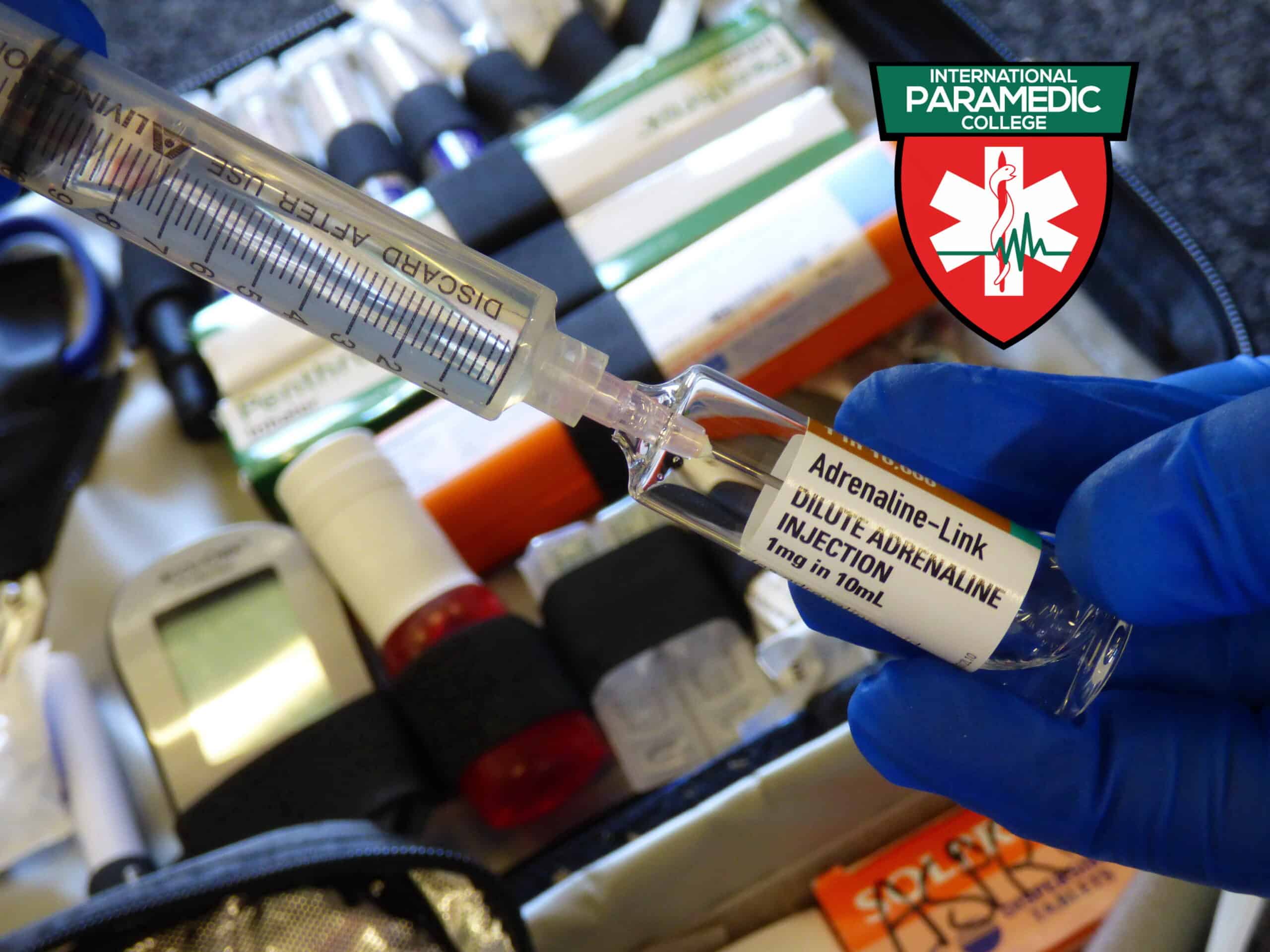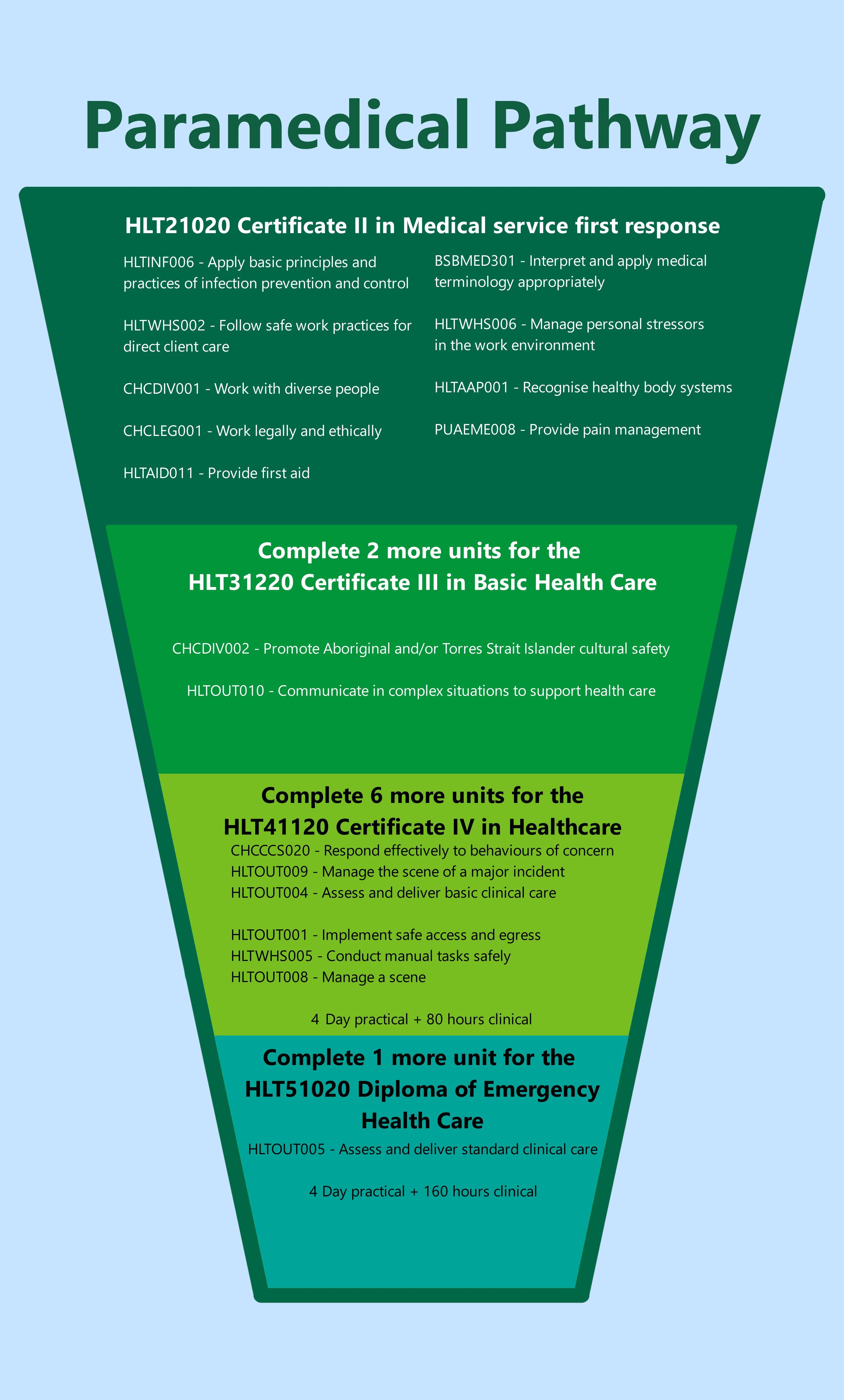
The healthcare industry in expected to grow by over 15 percent over the next five years, and Paramedicine skills are in high demand.
Here are some of the careers projected to grow into 2025.
%
Paramedics Predicted job growth to 2025
%
Health and Welfare Support Workers Projected increase by 2025
%
Percentage of full time employees Share of the market
Paramedical EMT Medic First Response Courses in Pre-Hospital Care
Unique Paramedic Pathway Designed Progression Program
Our range of Paramedical/ Medic Courses Run 100% Online and with practical face-to-face workshops in the Cert IV and Diploma.
Paramedics, or Emergency medical technicians (EMTs) as they tend to be called in America, play a crucial role in the Australian healthcare system, providing pre-hospital care to patients in emergency situations. Paramedics work alongside other healthcare professionals, such as, doctors, and nurses, to assess, stabilise and transport patients to medical facilities. Becoming a Paramedic in Australia requires national registration into the profession of Paramedicine. This is generally achieved by completing an approved university course and applying for national registration as a Paramedic. Becoming an EMT/medic first responder in event medical services, the mining sector or other jobs requiring advanced pre-hospital care training beyond the scope of first aid requires specialised training and education, which can be obtained through a vocational education pathway. In this article, we will discuss the benefits of pursuing a vocational paramedical education pathway and the requirements for becoming a Medic in Australia.
What is a vocational paramedic education pathway?
The recent changes to these vocational courses are significant and will make the courses simpler to deliver, which should make it easier to upgrade your training as well as becoming cheaper for students and provide a unique pathway approach.
Many “state based” Ambulance services in Australia require you to complete a degree prior to applying for employment as a paramedic. If that’s the dream, then we encourage you to enrol in a university and follow that path. An alternative option that may suit some people who are returning to learning or who may need to earn an income while they study or who may simply like to “test the water” a bit before they make a university commitment is to complete a vocational pathway and that will enable you to apply for advanced standing or recognition of prior learning (RPL) to gain entry into a university to complete a Bachelor of Paramedic Studies course later if that is how you decide you want to go. This vocational pathway will lead to significant savings in fees, and you can work and gain experience as you study. We recommend you look through seek to see what jobs are available and what qualifications employers are seeking before committing to any training. It is easy for us to sell you a course for the dream, but it is better for you that you have a clear look at the outcomes before you spend your money.
How do I become a paramedic? Try our pathway approach to becoming a paramedic?

A vocational paramedic education pathway is a training program that provides students with the necessary knowledge and skills to become a qualified EMT /Medic First responder Patent transport officer, NEPT. These programs are designed to be practical and hands-on, with a focus on real-life scenarios and simulations. Vocational paramedic education pathways can be completed in as little as six months to a year or 2, depending on the program, the level of qualification and the amount of tie you have to devote to your studies.
Why a vocational paramedic education pathway may be the best way to become a paramedic?
There are several reasons why a vocational paramedic education pathway may be the best way to become a paramedic. First, vocational paramedic education pathways are designed to be practical and hands-on, which means that students will have the opportunity to develop their skills through real-life scenarios and simulations. This type of training is essential as you need to be able to respond quickly and confidently in emergency situations.
Second, vocational paramedic education pathways are often more affordable and accessible than traditional university pathways. Many vocational education programs offer flexible study options, such as online learning and part-time study, which can be ideal for students who are working or have other commitments. Additionally, vocational education programs are often more affordable than university degrees, which can be a significant consideration for students who are looking to minimise their student debt.
Finally, vocational paramedic education pathways can provide students with a direct pathway to employment. Many vocational education programs have partnerships with healthcare organisations and ambulance services, which can provide students with opportunities to gain practical experience and secure employment upon graduation.
Do you need to have finished high school and have an ATAR to become a Paramedical student?
To become an EMT in Australia, you do not need to have finished high school or have an ATAR. However, you will need to meet certain requirements, which may include a minimum age requirement, a current driver’s license, and a police/ working with children check.
In general, vocational paramedic education pathways are designed to be accessible to students from a range of educational backgrounds. These programs provide students with the necessary knowledge and skills to become competent EMTs medics and proceed onwards to becoming an expert in pre-hospital care, regardless of their academic history.
Contact us and one of our paramedics, not a sales team, will call you to discuss our pathway and career options

The Paramedical Courses
HLT51020 – Diploma of Emergency Health Care
Payment plan and a special limited time 50% discount offer currently available. Click here for details.
HLT51020 – Diploma of Emergency Health Care is a nationally recognised qualification in Australia that provides the necessary skills and knowledge to work as a qualified paramedic or advanced life support paramedic. This diploma program is designed to provide students with a comprehensive understanding of emergency health care services, advanced life support procedures, and the ability to assess, diagnose, and manage a range of emergency medical situations.
The program typically takes between 18–24 months to complete and consists of both theoretical and practical training. The theoretical component of the program covers anatomy and physiology, pharmacology, medical terminology, communication, and advanced life support techniques. The practical component includes supervised clinical placements where students can apply their knowledge and skills in real-world emergency situations.
Graduates of the HLT51020 – Diploma of Emergency Health Care are equipped to work in a variety of emergency medical settings such as ambulance services, hospitals, and community health centres. They are also eligible to apply for further study in related fields such as nursing or paramedicine.
HLT41120 – Certificate IV in Health Care
HLT41120 – Certificate IV in Health Care is a nationally recognised qualification in Australia that provides students with the skills and knowledge required to work as a healthcare assistant in a variety of settings such as hospitals, aged care facilities, and community health centres. It is a great qualification for event medic staff and first responders.
The program typically takes between 6–12 months to complete and covers topics such as infection control, first aid, communication skills, health assistance, and workplace safety. The training is designed to provide students with practical skills and knowledge that they can use to assist health professionals in delivering high-quality care to patients.
Graduates of the HLT41120 – Certificate IV in Health Care are equipped to work in a range of entry-level healthcare roles, such as patient support, health assistant, or nursing support. They can also progress to further study in related fields such as nursing, paramedicine or allied health.
The program is also a pathway for those who want to upskill and pursue a career in the healthcare industry, as it provides a foundation for further studies in various healthcare-related courses.
HLT31220 – Certificate III in Basic Health Care
HLT31220 – Certificate III in Basic Health Care is a nationally recognised qualification in Australia that provides students with the skills and knowledge required to work as an assistant in nursing or healthcare support worker in a variety of healthcare settings such as hospitals, aged care facilities, and community health centres.
The program typically takes between 6–12 months to complete and covers topics such as infection control, first aid, communication skills, basic health care, and workplace safety. The training is designed to provide students with practical skills and knowledge that they can use to assist health professionals in delivering high-quality care to patients.
Graduates of the HLT31220 – Certificate III in Basic Health Care are equipped to work in entry-level healthcare roles, such as nursing assistant, health support worker, or personal care worker. They can also progress to further study in related fields such as nursing, allied health or aged care.
The program is also suitable for those who want to pursue a career in the healthcare industry but require an entry-level qualification to start with. It provides a foundation for further studies and career advancement in various healthcare-related courses.
HLT31120 Certificate lll in Non-Emergency Patient Transport (NEPT)
HLT31120 Certificate III in Non-Emergency Patient Transport (NEPT) is a nationally recognised qualification in Australia that provides students with the necessary skills and knowledge to work as a non-emergency patient transport officer. Non-emergency patient transport involves the safe and efficient transportation of patients who are medically stable and require transportation for medical appointments, diagnostic tests, or hospital transfers.
The program typically takes between 6–12 months to complete and covers topics such as infection control, communication skills, patient care, transport safety, and basic life support. The training is designed to provide students with practical skills and knowledge that they can use to safely and effectively transport patients in a non-emergency setting.
Graduates of the HLT31120 Certificate III in Non-Emergency Patient Transport are equipped to work in a variety of healthcare settings such as private patient transport companies, hospitals, and community health centres. They are also eligible to apply for further study in related fields, such as paramedicine or nursing.
This qualification is ideal for individuals who are passionate about helping people and want to work in a healthcare-related field, but do not wish to work in an emergency setting. The program provides students with the necessary knowledge and skills to provide high-quality patient care during transportation, ensuring the safety and well-being of patients at all times.
HLT21020 Certificate II in Medical Service First Response
HLT21020 Certificate II in Medical Service First Response is a nationally recognised qualification in Australia that provides students with the necessary skills and knowledge to respond to emergencies and provide basic first aid care. The program is designed to equip students with the skills to respond to emergencies and provide immediate care to sick or injured individuals until more advanced medical assistance arrives.
The program typically takes between 3–6 months to complete and covers topics such as basic anatomy and physiology, emergency response procedures, and basic life support. The training is designed to provide students with practical skills and knowledge that they can use to respond to medical emergencies and provide basic first aid care.
Graduates of the HLT21020 Certificate II in Medical Service First Response are equipped to work in a variety of settings such as sports events, music festivals, and community events. They can also progress to further study in related fields such as paramedicine or emergency medical services.
This qualification is ideal for individuals who are passionate about helping people and want to work in an emergency response setting. The program provides students with the necessary knowledge and skills to provide immediate care to sick or injured individuals and respond to emergency situations in a timely and efficient manner.
Office Hours
Mon - Fri
8.30am - 4.30pm
Training Partnership Shop Enquiries:
1300 244 994
training@internationalparamediccollege.com.au
Online Shoping
